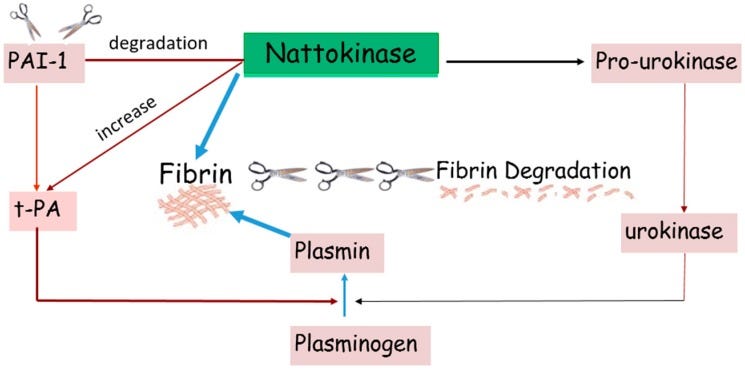Welcome back fellow subscribers - we’re in for a fun one today. A supplement I have a difficult time even calling a supplement its benefits can be so powerful. It’s gained a lot of popularity (& for good reason) this year within our esoteric corner of the health space.
Lucky for you - you’re way out in front of even most mainstream medical practitioners at this point. But today, we’re pushing your knowledge to the margin discussing the origins, potential health benefits we’ve seen so far in clinical trials, & some brands I trust at a dosage we’re seeing as most beneficial.
What we’ll cover this week:
What is nattokinase?
How it works
Benefits (as seen through the latest research)
Dosing
Some brands I personally trust
What is Nattokinase?
Nattokinase is a serine protease enzyme derived from nattō - a fermented soybean food consumed for more than 2,000 years as a traditional Japanese dish. Nattō is made by fermenting soybeans with a specific bacterium - Bacillus subtilis. For centuries, the Japanese associated nattō as a key to longevity. Japan currently ranks 2nd in the world in lifespan…causation? I’ll leave that up to you to decide.
Prior to the 1980s, nattō was regarded as superfood in Japanese culture without much knowledge as to why it was the case. Then in 1987, Dr. Hiroyuki Sumi, a researcher at the Chicago University Medical School, discovered nattō’s fibrinolytic activity while he was searching for natural substances to dissolve blood clots. Dr. Sumi isolated the enzyme responsible for this mechanism and named it nattokinase.
Following Dr. Sumi’s discovery, researchers started extensive research into nattokinase's potential health benefits - especially in cardiovascular health. Today, nattokinase is extracted from nattō offering a concentrated dose of the enzyme.
Mechanism of Action
If you’re less interested in how nattokinase functions, feel free to skip down to the next section - “Health Benefits”. But I’ll keep this to a cursory overview of how nattokinase acts.
The primary mechanism governing nattokinase's action potential is its ability to promote healthy blood flow through strong fibrinolytic activity - indicating nattokinase's ability to degrade fibrin. Fibrin is a critical protein required for blood clot formation. As we get older, our blood starts to become thicker → increased blood viscosity. Simultaneously, there's a decline in the natural clot-dissolving enzymes produced by our blood vessel lining cells. This thickened blood is more susceptible to clotting and doesn't circulate as efficiently potentially leading to a few harmful outcomes:
Increased blood pressure
Increased CVD risk
Reduced oxygen & nutrient delivery to peripheral tissues
Clotting includes a couple important aspects: 1) formation & 2) breakdown. What's unique about nattokinase is that unlike typical blood thinners on the market (i.e. warfarin, aspirin), it not only inhibits clot formation, but it also facilitates the break down of existing clots.
But how does this elevated level of fibrinolytic activity actually happen?
Let’s walk through the mechanisms in the diagram below:
Direct fibrinolysis
Nattokinase breaks down fibrin, the primary structural component of blood clots, through its proteolytic activity. Then, nattokinase splits specific peptide bonds within the fibrin molecule leading to the breakdown of the fibrin network.
Plasminogen Activator Inhibitor-1 (PAI-1) inactivation
First, plasmin is an enzyme responsible for the breaking down of fibrin clots in the blood. Nattokinase inactivates PAI-1 = the primary inhibitor of tissue plasminogen activator (tPA). By reducing PAI-1 activity, nattokinase indirectly enhances tPA-mediated plasminogen activation yielding increased plasmin generation. More plasmin = more fibrin degradation in blood vessels.
Increased tissue plasminogen activator (tPA) activity
Not only does nattokinase indirectly upregulate tPA via PAI-1, it also directly acts on it. This increased tPA activity again results in more efficient conversion of plasminogen to plasmin further amplifying the fibrinolytic cascade.
Pro-urokinase activation
Nattokinase activates pro-urokinase to urokinase - the key enzyme that converts plasminogen to plasmin.
Together, these four actions provide nattokinase its five major properties:
Anti-atherosclerotic
Antihypertensive
Antiplatelet
Antithrombotic
Neuroprotective
Like any supplement, there's a complex interplay of mechanisms working in the background simultaneously as well. For example, nattokinase possesses additional properties like being an antioxidant, anti-inflammatory, & anticancer tool. However, much of the heavy lifting we see in terms of the health outcomes are being driven by its strong tendency to break down fibrin and ultimately support healthy blood flow.
Let's see what some of those benefits are.
Health Benefits
Alright, enough of the nerdy mechanism talk. Let’s talk about what nattokinase is actually capable of on outcomes. As always, I'm going to deliver to you the latest robust forms of evidence we've seen to date beginning with strong human clinical trials, then briefly discuss a couple noteworthy animal studies & a review conducted by a name many will be familiar with.
Human Trials
Cardioprotective
One of the most compelling trials conducted thus far involved a study of 1,062 participants and nattokinase’s effects of NK on atherosclerosis and hyperlipidemia.
Following a 12-month period of 10,800 FU/day consumption of nattokinase, subjects saw significant improvements in lipid biomarkers: 16% decrease in triglycerides, 18% decrease in LDL-C, and 16% increase in HDL-C.
Keep reading with a 7-day free trial
Subscribe to BowTiedPhys to keep reading this post and get 7 days of free access to the full post archives.







